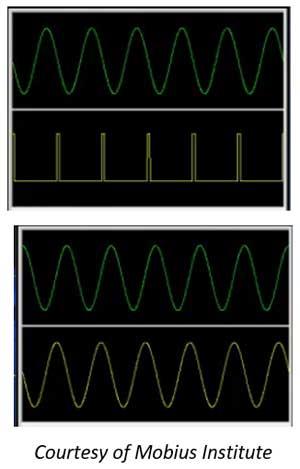Vibration analysis is a non-destructive testing method that can identify problems with rotating machinery. Analyzing the vibration signals from a machine makes it possible to detect early signs of wear, misalignment, and other issues that could lead to failure.
This article is for plant engineers, maintenance personnel, and anyone interested in learning more about vibration analysis. It will provide an overview of the technology and explain how it can be used to identify equipment problems.
How It Works
Vibration analysis is based on the principle that all rotating machinery vibrates. The frequency and amplitude of these vibrations can be used to identify problems with the machine. The speed of rotation of the machine determines the frequency of vibration. The severity of the problem determines the amplitude of the vibration.
Vibration analysis can identify many problems, including bearing wear, misalignment, looseness, unbalance, rotor rubs, and mechanical damage.
How to Use
Vibration analysis can be used in a variety of ways. It can conduct routine maintenance, monitor equipment conditions, investigate problems, and develop preventive maintenance programs.
To use vibration analysis, you will need to collect vibration data, analyze the data, and take corrective action. Vibration data can be collected using various devices, including portable vibration meters and permanent vibration monitoring systems. When collecting vibration data, selecting suitable sensors, placing them in the correct locations, and collecting data for a sufficient period is essential.

Methodology
Accelerometers have been the go-to tools for collecting vibration data. But the rapid advancements in sensor technology have paved the way for non-contact, high-speed laser sensors. These cutting-edge sensors offer improved accuracy and localized analysis capabilities, expanding the horizons of vibration analysis methodologies. By incorporating these state-of-the-art sensors, maintenance teams can enhance the precision and effectiveness of their vibration analysis techniques.
Principles
Vibration analysis is built upon four fundamental principles, each providing valuable information about vibrating parts' working conditions and characteristics.
- Time Domain: The time domain captures vibration signals picked up by transducers and displayed as waveforms on an oscilloscope. It plots amplitude against time, offering insights into machinery vibration issues that may not be discernible through spectrum analysis alone.
- Frequency Domain: By subjecting waveforms to spectrum analysis, the frequency domain reveals a visual representation of frequency versus amplitude, known as a spectrum. The frequency domain is the primary platform for in-depth machinery vibration analysis, leveraging spectrum analysis techniques.
- Joint Domain: Given that vibration signals exhibit variations over time, the joint domain employs a collective time technique called Gabor-Wigner-Wavelet. This technique facilitates the simultaneous calculation of many spectra, such as the short-time Fourier transform (STFT), enabling a comprehensive analysis of vibration characteristics.
- Modal Analysis: Modal analysis involves capturing frequency response functions of machinery and integrating them into computer models. These models enable the visualization of different vibration modes through animations, helping maintenance professionals make informed adjustments by manipulating factors like mass or stiffness.
Analysis
Once you have collected vibration data, you must analyze it to identify any problems. There are several software programs available that can be used to analyze vibration data.
When analyzing vibration data, it is essential to look for trends, compare the data to historical data, and use statistical analysis. Once you have identified a problem, you must take corrective action. The corrective action you take will depend on the severity of the problem. In some cases, you may be able to correct the problem by adjusting the machine. In other cases, you may need to replace parts or the entire machine.

Approaches
Beyond the foundational principles of vibration analysis, many analysis methods, calculations, and algorithms contribute to a comprehensive understanding of machinery vibrations. Some of these approaches include:
- Time Waveform: Time waveforms present acceleration versus time as tables and plots, providing valuable insights into machinery conditions that may not be evident in frequency spectra alone. The Fast Fourier Transform (FFT) is often employed to convert time waveform signals into the frequency domain, facilitating using time waveforms as a vibration analysis tool.
- Fast Fourier Transform (FFT): FFT is an algorithm used to calculate spectra from time waveforms, breaking down a signal into its constituent frequencies. This technique is employed to detect machine faults such as misalignment or unbalance.
- Phase Measurement: Phase measurement involves determining the relative time difference between two signals, measured in angles rather than time units. This approach, combined with FFT analysis, aids in identifying machine faults like loose parts, misalignment, and unbalance.
- Order Analysis: Order analysis is a variation of FFT analysis that quantifies vibrations in machines with varying revolutions per minute (RPM). Instead of using hertz, order analysis presents the spectrum's frequency axis in RPM-based orders. This technique helps identify frequency multiples of a reference rotational speed, offering insights into machine performance.
- Power Spectral Density (PSD): PSD calculations involve multiplying FFT amplitudes by different forms to normalize them with the frequency bin width. This approach compares random vibration signals with varying signal lengths, providing a comprehensive view of motion across many frequencies.
- Envelope Analysis: Envelope analysis is a specialized vibration analysis method that detects low-energy impacts hidden within other vibration signals. This technique is beneficial for diagnosing issues like damaged gear teeth and roller bearings.
- Orbit Analysis: Orbit analysis entails plotting the centerline of a sleeve bearing journal, measured by placing two probes 90 degrees apart in the bearing housing. The data from these probes can be digitally displayed and used to detect shaft vibrations caused by oil whirl, where the oil within the bearing housing generates a whirlpool-like motion, affecting the journal.
- Resonance Analysis: Resonance analysis focuses on identifying machinery's natural vibrations and frequencies. The resonance indicates high vibration levels, which may lead to damaging effects if not addressed promptly.
Conclusion
Vibration analysis is a powerful tool that can help to prevent costly equipment failures. By identifying problems early, plant engineers and maintenance personnel can take corrective action before a failure occurs. This can save money, improve safety, and increase productivity.
We offer a comprehensive training program to enhance your understanding and application of vibration analysis. Our training program is designed to effectively equip you with the knowledge and skills to assess machinery health using vibration analysis techniques. Learn how to interpret vibration data, diagnose common equipment problems, and implement proactive maintenance strategies.
Besides training, we also provide practical solutions for proactive maintenance. Take advantage of CRE Philippines’ Oil Analysis Program to monitor the health of your equipment. Our experts can identify early warning signs of wear, contamination, and other factors affecting performance by analyzing oil samples. Stay one step ahead and optimize the reliability of your operations.
By combining the knowledge gained from our training program with the insights provided by our Oil Analysis Program, you can take proactive measures to prevent equipment failures, reduce downtime, and increase operational efficiency.
Start harnessing the power of vibration analysis today and unlock a new level of equipment reliability. Invest in our Vibration Analysis Training Program and explore our Oil Analysis Program to stay ahead of the curve. Remember, a proactive approach to maintenance is critical to optimizing your operations and ensuring long-term success. Contact us today to learn more.
Source:
Reliable Plant. (2023, March 8). How to Use Vibration Analysis to Identify Equipment Problems. Retrieved from https://www.reliableplant.com/Read/31055/how-to-use-vibration-analysis-to-identify-equipment-problems
Reliable Plant. (2023, June 5). Vibration Analysis Explained. Retrieved from https://www.reliableplant.com/vibration-analysis-31569


